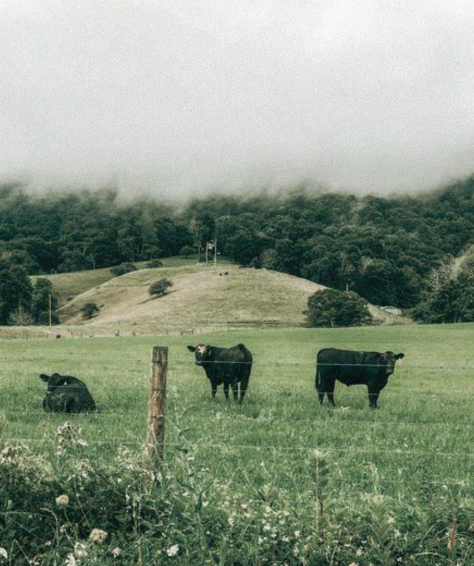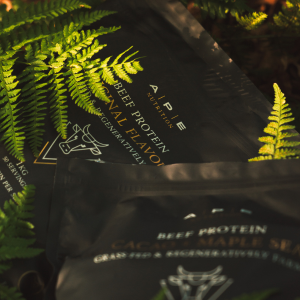Please see below our letter in response to the Major of New York, Eric Adams, introducing Meatless Mondays, Vegan Fridays and making plant based meals the default in hospitals...
Dear Eric Adams,
Please read these words with an open mind and know that I am trying to help you do what is best for New York, the city you are privileged to be custodian of.
I appreciate that you want to reduce New York’s food related greenhouse gas (GHG) emissions by 33% before 2030. On the surface this is a great endeavour and in principle I support you. However, I’m writing to you today to explain why the approach you are using is based upon flawed information, will send the wrong message and do more harm than good. That said, it’s not all doom and gloom, I’m going to suggest a really promising alternative solution to be explored.
First, I’d like to address your statement that “plant powered food isn’t just good for our physical and mental health, but it’s good for the planet as well.”
Although I agree that plant food, when grown truly organically, is beneficial to our health and is good for the planet. The method by which it is grown is a crucial factor and therefore a distinction that must be made. Fruit and vegetables that have been farmed using mono-cropped agriculture (which is the majority of them) are in fact bad for both humans and the environment for the reasons below:
- Through the use of chemical inputs, this method of farming kills soil micro-organisms, reducing the soils ability to sequester carbon from the atmosphere, hold water (which can lead to flooding and chemical run-off into rivers) and ultimately leads to desertification (the soil losing all biological activity and literally becoming desert).
- As a result of the reduction in soil health and micro-organisms, the plant foods produced have a reduced nutritional value. One study found that the magnesium content of vegetables decreased by around 20% between 1930-1980. Not only this, but the foods produced have trace amounts of the chemicals (pesticides, herbicide and fungicides) on them. These are toxic to humans, have been linked to cancer and have many downstream negative impacts, including disrupting the gut microbiome.
- Growing the same crop in the same area year on year and using combines to harvest it also reduces wildlife biodiversity and leads to the indirect death of a huge number of animals. Mice, rabbits and all the other small creatures that live underground are chopped up when fields are plowed. Birds and reptiles are killed when they eat bugs covered in pesticides. Fish die when fertilisers run off fields into nearby rivers.
On the other hand, when fruit and vegetables are grown on regenerative farms, quite the opposite happens. Soil health is enhanced, the nutrient quality of food increases, there are no chemical inputs to harm human health or kill animals. You can literally take every negative impact of industrial agriculture listed above and it becomes the positive opposite within a regenerative farming system.
However, regenerative farming does not work without animal inputs. It relies on natural, un-harmful fertiliser in the form of manure. Working in harmony with nature, regenerative farming does exactly what it says on the tin; it rebuilds nature from the ground up, providing a solution to both the health and environmental crises we’re faced with today.
Now I’d like to look at some of your policies aimed at reducing food-based emissions:
- The introduction of ‘Meatless Mondays’ and ‘Vegan Fridays’ to the school lunch programme for public school children.
Firstly, meat is an incredible source of bioavailable nutrients. Studies have shown that excluding it from the diet results in a number of nutrient deficiencies, including; vitamin A, B12, creatine, carnitine, choline, iron and zinc. These nutrients are essential for anyone to function optimally, however are especially important for the developing brains and bodies of children.
Don’t just take my word for it though, a new report released on the 25th April 2023 from the Food and Agriculture Organisations (FAO) of the United Nations (UN) concluded that meat, eggs and milk are essential sources of nutrients for human health.
"Meat, eggs and milk, offer crucial sources of much-needed nutrients which cannot easily be obtained from plant-based foods and have important health and developmental functions." Such as, "high quality protein, a number of essential fatty-acids - together with iron, calcium, zinc, selenium, Vitamin B12, choline and bioactive compounds like carnitine, creatine, taurine."
In addition to this, removing meat from school menu’s for the sake of human and planetary health teaches children that meat is bad. This in itself is worrying enough, as it drives the younger generation further away from the way humans have eaten for the vast majority of existence. Also, as there isn’t any education around nutrition, this may result in the consumption of more highly processed vegan products full of vegetable oils, which are extremely detrimental to health. This dietary shift quite literally makes the younger generation guinea pigs for developing under this new, unnatural way of eating. Animal products have been prised by humans for our entire existence. We need the nutrients from them to nourish our bodies and thrive. Also, as pointed out above, without using animals within a regenerative farming system, it doesn’t work. The animals don’t just enable us to grow plant foods with more nutrients in them, but farming them in a way that mimics how they would have existed in nature also provides a whole host of environmental benefits.
The response I commonly receive to the above statement about us requiring the nutrients from animal foods to thrive is; ‘we can supplement those nutrients’.
Whilst that is technically true, it’s; 1) hard to work out, 2) potentially impossible in some cases (due to certain polymorphisms e.g. if you have the BC01 gene, you can’t convert beta-carotene (the plant form of Vitamin A) into Retinol (the animal form that we actually use) and 3) more expensive.
To unpack why it’s hard to work out, let’s take the example of supplementing with calcium for bone health. Firstly, we need both calcium and phosphorous in the right ratio of (2:1) for strong bones. Taking a calcium supplement in isolation will actually overwhelm the body with calcium, resulting in reduced levels of phosphorous in the body and therefore won’t have the desired effect. Therefore you need to take a calcium supplement with around half the amount of phosphorous in it, or pair a calcium supplement with a phosphorous rich food. You can see how this could quickly become complicated if you were taking a lot of supplements. You’d not only have to have the awareness of how multiple nutrients interact with each other, but you’d also have to ensure you were pairing foods and supplements correctly every time you eat. On the other hand, if you’re getting your calcium through real foods like raw grass-fed dairy, this provides both these nutrients in this ideal ratio and therefore supports strong bones naturally and without the calculations.
In terms of the expense related to supplements, this might not be an issue depending on your level of income. However, I highly doubt the public school children of New York will be dipping into their pocket money to buy supplements and this might not be feasible for their parents either. On top of this, it’s highly unlikely that children are going to remember to take a variety of supplements every day.
- The introduction of plant-based meals as the default option in New York hospitals.
The food that we eat acts as the building blocks for our brain and bodies. It’s important to have adequate amounts of all of the nutrients that are commonly lacking on a vegan diet to function on a day to day basis. However, they become even more important when we’re recovering from an illness, injury or operation.
For the sake of time, I’m just going to highlight the impact a few likely deficiencies could have on recovery:
- High quality protein
When we talk about eating protein, what we’re really talking about is consuming amino acids. Amino acids are often referred to as the building blocks of protein as they’re needed for protein synthesis within the body. Protein synthesis is always important as it’s required for us to maintain and build muscle (the organ of longevity). However, this process is vital when we’re recovering from an injury (often the case in the hospital) as we don’t just need enough protein to maintain our muscle mass but also to rebuild anything that’s been broken down.
There are 20 amino acids, 9 of which are essential, meaning we need to get them through diet. Due to their amino acid profile, plant foods are lower quality protein sources when compared to animal foods. Meat, eggs and dairy contain all the essential amino acids (EEAs), meaning we can readily synthesise protein within the body from just consuming these alone. Whereas plant sources such as beans are incomplete proteins as they do not have enough of certain amino acids in them. Therefore you need to intelligently pair plant proteins to get all the EEAs required to enable protein synthesis. It’s not impossible to get enough EEAs from plant food alone, it just takes a lot more food knowledge and planning. Also, getting enough EEAs through plant foods will likely result in you consuming quite a lot more calories, not ideal when you’re laying in a hospital bed with minimal energy expenditure.
- Zinc
Two key roles of the mineral zinc are; wound healing (via boosting collagen synthesis) and immune function, making this an extremely important nutrient for someone recovering from any sort of skin damage or illness. Zinc is great for immunity because we use it to create immune cells, such as T-cells and white blood cells. These immune boosting compounds help the body fight off infection and other diseases.
Due to the presence of anti-nutrients that block the absorption of zinc, bioavailability (how much we can actually use) from plant foods is poor. Studies have shown that the bioavailability of zinc in Western omnivore diets is between 20-50%, making optimal dietary intake between 20-40mg daily. When following a vegetarian diet, to compensate for the lack of bioavailability, it’s suggested that males need to consume 16-20mg more zinc and females 12-14mg more per day.
- Iron
There are two types of dietary iron; heme and non-heme. Heme iron is the type found in animal foods, whereas non-heme is the type found in plant foods. Heme iron is more bioavailable and is absorbed at 15-40%, whereas non-heme iron is absorbed at 1-15%. This is partially because the uptake of the non-heme is inhibited by anti-nutrients such as physic acid, which is also present in plant foods such as; whole grains, legumes, lentils and nuts as well as polyphenols found in tea, coffee, red wine, cereals, vegetables and spices.
Studies has shown that individuals consuming vegetarian diets have lower levels of haemoglobin, which is made from heme-iron and is part of red blood cells. Red blood cells are extremely important, especially for those recovering from illness or injury as they; carry oxygen and nutrients around the body, form blood clots to prevent excess blood loss and carry antibodies to fight off infection.
From my explanations above, I hope you can understand why meat is an extremely important part of the human diet, especially for children and people recovering from illness or injury. I hope you can also see that the way food is grown is a vitality important distinction that needs to be made in any conversation around diet. Animal and plant foods alike can both be bad for our health and the health of the planet when they are farmed using industrial agriculture methods. Whereas regenerative farming works in harmony with the environment, improving soil health, having the highest standards for animal welfare and providing us with food that is more nourishing to the body. Instead of Meatless Mondays, Vegan Fridays and plant based meals being the default option for New York hospitals, I encourage you to explore how you can provide children and those recovering with regeneratively farmed meals including both meat and plant foods.
Here's to More Life,
Josh & Izzi






